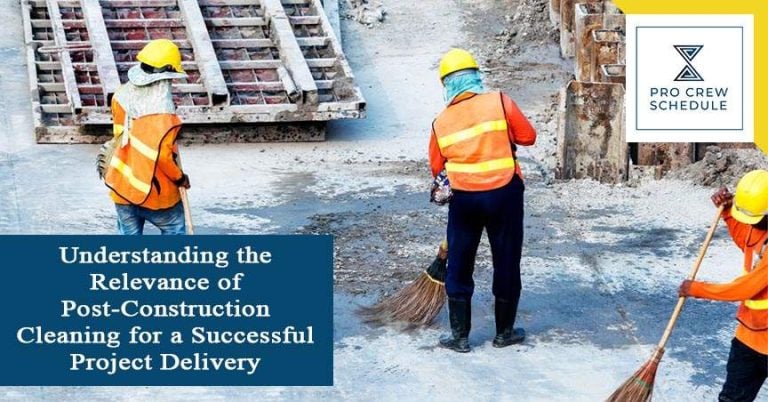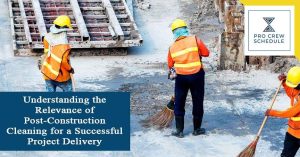As a project manager or a general contractor, any company’s end goal is to turn the client the keys to a construction project, whether a new building or a renovation. But your work is not done until it is not yet accepted. When a building project is done, the last step is to check the job site carefully to ensure everything is clean, organized, safe and put away.
Before the final handover of the project, a few more things need to be done on the building. Usually, a construction punch list is utilized to ensure that all loose ends are taken care of, any damage is fixed, and the property is up to the required quality standards. And these include cleaning the whole building or after construction, or what is known as post-construction cleaning. In this article, let us study post-construction cleaning, its phases, and why it is necessary for successful project delivery to the clients.
What is Post-Construction Cleaning?
A subcontractor may clean up general trash around the job site, but cleaning in great detail is no longer part of their job. Post-construction cleaning is done from top to bottom – it is more than just sweeping the floor, vacuuming the carpet, and cleaning other areas that people can see. During construction, dust is made, which sticks to things like windows and cabinets. Some of the materials left over from your project may be dangerous, like wires, glass, and nails.
It is critical to clean up after the work is done during the construction project. You have the option to clean it yourself or hire construction clean-up services to help make the project clean and presentable to the client.
Why is Post-Construction Cleaning Important?
When a construction job is done, it leaves behind a huge mess. Any commercial or residential construction site needs cleaning after the work is done. A lot of dust is made when construction work is done, and it floats through the air. These particles can stick to every new building corner and make it look dirty. It lowers the value of your home and changes the air quality inside. Some of these particles could be silicates and other poisons that hurt the lungs, compromising your workers and your client’s health.
When a building is going on, many things could cause serious accidents. A lot of trash on construction sites makes it likely that someone will get hurt. A solid construction waste management system can help you dispose of construction wastes, lessening the things you need to clean up after the project.
What is A Post Construction Cleaning Checklist?
Creating a checklist is the way to go if you feel lost on how to go about post-construction cleaning. A post-construction cleaning checklist is a detailed list that divides the different parts of a job site into categories that need to be cleaned. It can help your workers go through each area and figure out what needs to be cleaned up before the project can be done, from the floors, windows, and ceilings to the exterior features and the trash and debris removal. Here are a few areas that you should consider in your list:
- Entrances & Exits
- Windows
- Living/Common Areas
- Kitchens
- Bathrooms
- Bedrooms
- Balconies
- Outdoor Spaces/ Landscaping
What Are the Three Phases of Post-Construction Cleaning?
The post-construction cleaning can be broken up into three simple phases: namely, rough cleaning, light cleaning, and touch-up stages. In the section below, let us discuss each step of the process.
Phase 1. Rough Cleaning
Rough cleaning involves getting rid of all the dust, debris, and trash on the job site. Its main goal is to eliminate large items – you will need to eliminate the more significant pieces of waste and debris and any leftover building materials, disposable containers, and tools. Garbage, trash, leftover materials, and other things cannot be vacuumed and should be moved to a construction dumpster. Once you are done with the initial steps, the next one would be to clean everything to eliminate any dust, silicates, or particles lying around.
Phase 2. Light Cleaning
This part of the post-construction cleaning process is the one that needs more work than the other two. During this step, the cleaners focus more on making every aspect of the project as clean as possible. It also requires a lot of cleaning tools and equipment. Rooms with specific uses, like bathrooms and kitchens, are getting exceptional care. During this phase, installed items like sinks, toilets, windows, and cabinets are cleaned. Cleaners can mop the floors and use vacuum cleaners to clean them. The cleaners will clean the cabinets from top to bottom and take great care when cleaning the baseboards. The cleaners use various tools during this step, such as neutral cleaners and microfiber rags.
Phase 3. Touch-Up Cleaning
This is the last crucial step in the post-construction cleaning process. After a few days, it usually takes the cleaners a week to figure out where most of the dirt is. Here, the cleaners should be more focused on making the place spotless and squeaky clean. During this phase, they will clean up all the fingerprints, smudges, and stains on your surface. The cleaners will clean the garage, vacuum the carpets, and mop the floors during this step. They add the finishing touch to your home and look at the whole space to ensure nothing is missed.
They can also clean carpets and rugs, use pressure to clean concrete or outdoor surfaces, and clean windows. These parts do not usually get much attention during a new construction clean-up. After that, the place is fixed up is looked at one more time.
Few Tips on Making Your Project Presentable for Delivery to the Clients
No matter the size and scope of a project, construction wastes are inevitable. When this happens, cleaning up after construction must be included when planning your project’s schedule in construction management software. In this section, let us read a few tips on utilizing the post-construction process more effectively and efficiently and making your project presentable for handover to your clients.
Take Precautions
During construction, you include cleaning up on your job site after a day’s work. This is to prevent any trash buildup which can make your site cluttered. Before you start cleaning in detail, get as much dust as possible. Taking precautions saves time and keeps you from having to clean up more. You can also consider cleaning materials or equipment during your construction procurement stages.
You can use the right amount of plastic sheets and tape to seal off finished areas and keep them free from dust by carefully attaching the plastic to the walls and using materials that will not damage the paint when it is taken off. Another tip is to block all vents and other places where air can get in and out since dust can settle quickly inside, preventing dust builds up in air ducts.
Start From the Inside Going Out
When cleaning a room by room, the cleaning staff should always start at the farthest corner and work their way to the door to keep the dirt from getting into places already clean. Start at the top and work your way down the walls so when the loose stuff falls, the floor can be cleaned. If there is a lot of dust, spraying the floor lightly with water will make it easier to sweep.
Vacuuming Twice
When cleaning up after a construction project, a good vacuum cleaner is the best investment you will ever make. Each room should be vacuumed twice after sweeping and again when you’re done with everything else.
When the first round of vacuuming is over, leave so the dust can settle. When it is time, you should rerun the vacuum and eliminate all the dust.
Cleaning Surfaces
After a construction project, many surfaces often have a lot of different kinds of residue on them, whether it is wooden, tiled, or painted. Here are some steps you can take to keep your surfaces clean:
- If there are any leftover construction materials on the surface, gently remove them with a damp sponge and wipe the area with a dry towel.
- Using a plastic putty knife can scrap any residue that will not come off with the sponge. Using this can help you prevent accidental scratches on the surface.
- Once everything has been scraped, use a clean, dry towel to wipe and buff the surface.
- For stains that will not come off, you can use various solutions or DIY techniques to remove them, such as window cleaner or a small amount of white vinegar.
- If the leftover building material is dehydrated, you can soften it with oil. Then, use a plastic putty knife to scrape it gently.
Cleaning Carpets
Carpets are probably the hardest to clean since they are heavy and absorb dust more quickly. Do not try to get sticky things off carpets because you could do more damage. Instead, let the material dry, break it up, and vacuum it. If it does not work, you can spray the stain with a carpet cleaner and blot the area with a microfiber cloth, paper towels, or another absorbent fabric.







